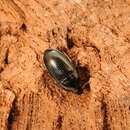Conservation Status
provided by University of Alberta Museums
No specific information available on conservation of this species in Canada. Other reports suggest conservation of semi-natural grasslands and gaps on forest exteriors has positive effects on this species (Taboada et al., 2010).
- license
- cc-by-nc
- copyright
- University of Alberta Museums
Distribution
provided by University of Alberta Museums
Amara familiaris is introduced species in North America. This species has Palaearctic distribution and occurs mainly in Eurasia and Siberia. In Canada, it is recorded from New Brunswick, Nova Scotia, Newfoundland, Quebec, Ontario, British Columbia, Alberta (Lindroth, 1968, CBIF, 2010).
- license
- cc-by-nc
- copyright
- University of Alberta Museums
General Description
provided by University of Alberta Museums
It is a small species with adults measuring from 5.6 to 7.2 mm. Legs dark or dark black in colouration with greenish or bluish glossy upper surface. Antennae have segments 1 - 3 with base of at least 4. Eyes flat, prothorax with angular protruding front angles and shallow basal foveae which are surrounded by a group of punctulae. Elytral striations apically deepened. Male copulatory organ (penis) straight and slightly bent and possesses lateral lobes (parameres) (Lindroth, 1968).
- license
- cc-by-nc
- copyright
- University of Alberta Museums
Habitat
provided by University of Alberta Museums
Open grounds with weedy vegetation. Greater abundance in habitats with weeds such as Stellaria media and Polygonum aviculare (Lindroth, 1968).
- license
- cc-by-nc
- copyright
- University of Alberta Museums
Life Cycle
provided by University of Alberta Museums
Adults overwinter in soil and emerge in spring and become sexually active. Their emergence is followed by dispersal and colonization of weedy areas and abandoned fields with profuse weed growth. Larval stage has three instars which feed on weed seeds. Larvae are active from April to mid-June. Third larval instar undergoes pupation in the upper surface of soil. First generation adults further overwinter to emerge in spring (Saska and Honek, 2008).
- license
- cc-by-nc
- copyright
- University of Alberta Museums
Trophic Strategy
provided by University of Alberta Museums
This species is a specialist seed feeder and larvae feed extensively on the seeds of common chickweed, Stellaria media (Klimes and Saska, 2010). However, adults also feed on unripe seeds of hickweed (Cerastium sp.) and grass seeds (Lundgren, 2009). Female fecundity is dependent on seed feeding and they do not reproduce until they have fed on the seeds of S. media (Saska, 2008).
- license
- cc-by-nc
- copyright
- University of Alberta Museums
Amara familiaris
provided by wikipedia EN
- license
- cc-by-sa-3.0
- copyright
- Wikipedia authors and editors
Amara familiaris: Brief Summary
provided by wikipedia EN
Amara familiaris is a species of ground beetle native to Europe.
- license
- cc-by-sa-3.0
- copyright
- Wikipedia authors and editors

